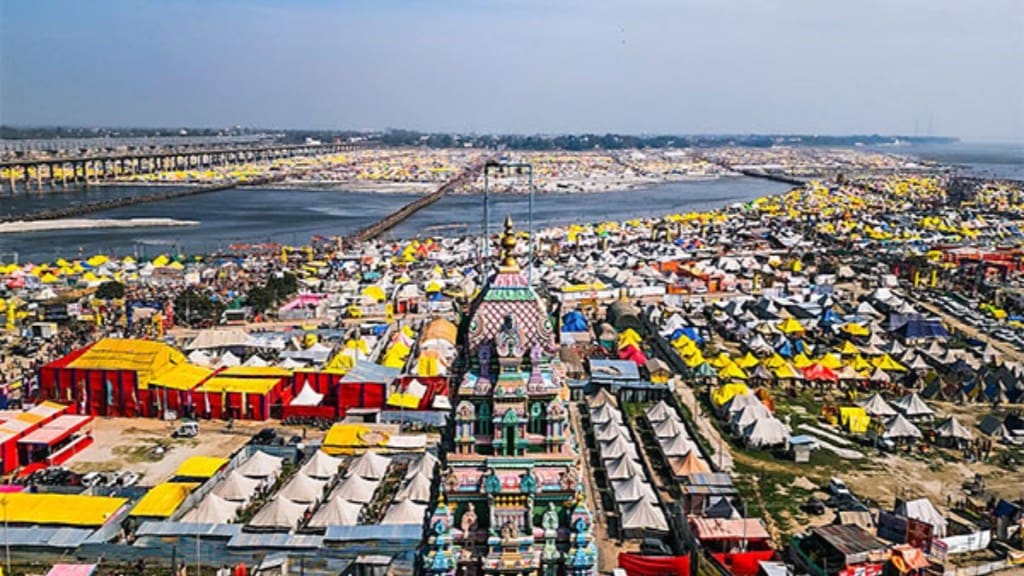Beneath the kaleidoscopic chaos of the Maha Kumbh Mela in Uttar Pradesh lies an economic juggernaut, fueled by the faith of an estimated 40 crore people expected to descend on the banks of the Ganga in Prayagraj from today (January 13) onwards. The Mela has become a vast, pulsating marketplace where every decision — whether setting up a food stall, leasing a tent city, or launching a floating jetty room — carries the weight of opportunity and risk.
The historical city of Allahabad, now known as Prayagraj, has hosted countless Kumbhs — since “anaadi kaal” or times immemorial. This year, with the government launching a massive blitz in preparation for what is expected to be a record turnout, the city and its economy are looking to gain a significant boost.
Mahakumbh Mela 2025 Live Updates
Officials say the government is focusing on creating a massive economic impact through the Mela. For the next 45 days, the Mela grounds, spanning 4,000 acres along the riverbanks, will host pilgrims in various tent accommodations, from basic to luxury, alongside many food stalls.
Infrastructure development worth Rs 6,990
The Yogi Adityanath-led BJP government has initiated 549 projects, spanning infrastructure development to sanitation, with a budget of Rs 6,990 crore for the Maha Kumbh. In comparison, the 2019 Kumbh Mela had 700 projects at a cost of over Rs 3,700 crore. Officials estimate that the Mela will generate Rs 25,000 crore in revenues and have a broader economic impact of Rs 2 lakh crore on the state’s economy.
CII predicts Rs 25,000 crore turnover from event
Mahendra Kumar Goyal, president of the UP chapter of the Confederation of All India Traders, predicts a turnover of Rs 25,000 crore from the event, with Rs 5,000 crore from puja items, Rs 4,000 crore from dairy products, and Rs 800 crore from flowers. The hospitality sector, especially luxury hotels, is expected to generate Rs 6,000 crore.
Alok Shukla, President of the UP chapter of the Confederation of Indian Industry (CII), calls the Maha Kumbh a “golden opportunity” for local businesses, with “revenues equivalent to one year’s worth of business compressed into two months.”
Luxury stays in tents priced at up to Rs 1 lakh a night
In a competitive bidding process for spots at the Mela grounds, the state government invited private entities to bid. The highest bidders were allotted stalls. “We have received Rs 1-2 crore from each bidder to set up stalls in Kumbh. The impact is immense,” Additional District Magistrate Vivek Chaturvedi was quoted as saying by The Indian Express.
A staggering scale of investment has gone into accommodation for the Mela. The UP government has set up 1.6 lakh tents, including 2,200 luxury tents and many smaller ones along the riverbanks. There are also 218 hotels, 204 guest houses, and 90 dharamshalas in the city.
The luxury tents, priced between Rs 18,000 and Rs 20,000 per night, come with amenities like private bathrooms, blowers, Wi-Fi, and even butler services. Premium accommodations, like those at Sangam Nivas Prayagraj, are priced at Rs 1 lakh per night for two guests, offering en-suite bathrooms and high-end services. With demand high on auspicious bathing days, all 44 super-luxury tents at Sangam Nivas are sold out, say UP government officials.
The Uttar Pradesh State Tourism Development Corporation (UPSTDC) has four categories of tents — Villa, Maharaja, Swiss Cottage, and Dormitory — with prices ranging from Rs 1,500 per night for dorms to Rs 35,000 for the high-end ones.
From food courts to major food chains – Food and hospitality boom
Brothers Mitesh and Ashwin Thakkar, directors of RR Hospitality Pvt Ltd., have invested Rs 12-13 crore to set up food courts and outlets across 14 of the Mela’s 25 sectors, employing over 500 workers. One of their most expensive outlets was secured after a bid of Rs 1.23 crore near the Sangam area.
“We were competing for a tender for Rs 7 crore but lost to an amusement park vendor who bid Rs 11 crore,” says Ashwin. Despite missing out on McDonald’s due to “time constraints,” they have managed to attract brands like Starbucks, Coca Cola, and Domino’s and are targeting a Rs 100-200 crore turnover.
“The key is speed and flexibility,” says Mitesh. “We had planned to set up a stall near the Dome City at Arial Ghat, but with construction still ongoing, we decided to relocate our food courts.”
100 homestays, 7,000 vendors registered for Kumbh
On the anticipated massive turnout, Chaturvedi added, “We took the help of Allahabad University to figure out how to increase the footfall at the Mela by augmenting the infrastructure. Special corridors have been designed to handle an influx of 10,000 to 20,000 pilgrims at a time. Floating jetties, water sports, and temple tourism have been introduced to enhance the event’s appeal while boosting tourism retention.”
Regional Tourism Department officer Aparajita Singh notes, “There was a push to improve hotel infrastructure. We now have 100 homestays registered with us compared to just 15 last year. There are over 7,000 vendors in the city, of whom 2,000 have undergone skill development training for digital payments. We have set up a team of 1,000 guides and expanded the food court systems to ensure we give tourists all modern facilities.”
Major drivers of the pop-up economy
For small and large businesses on the Mela grounds and beyond, the Kumbh Mela represents both a gamble and an opportunity where faith, hard work, and market dynamics intersect.
Professor Badri Narayan, Director of Govind Ballabh Pant Social Science Institute, says, “The Maha Kumbh Mela touches everyone — from a rag picker to a luxury hotel owner. The Mela may generate around Rs 200 crore in business this year, providing temporary livelihoods for small vendors and workers.”

